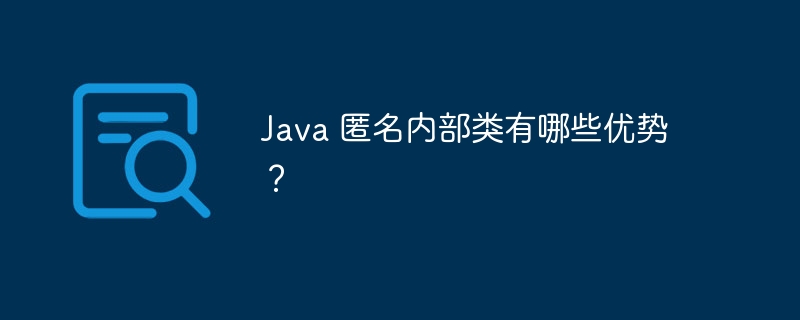What are the advantages of anonymous inner classes in Java?
Anonymous inner classes are used in Java as special inner classes that facilitate subclassing, simplifying code, and handling events (such as button clicks). Practical cases include: Event handling: Use anonymous inner classes to add click event listeners for buttons. Data transformation: Sort collections using the Collections.sort method and an anonymous inner class as a comparator.

Java Anonymous Internal Classes: Advantages and Practical Cases
Anonymous internal classes are a special type of internal class in Java. It is easy to create and use without explicitly defining a class name. They have the following advantages:
- Flexible creation of subclasses:Anonymous inner classes allow instances of subclasses to be quickly created when needed without having to define a separate class.
- Simplify code: Compared with using ordinary inner classes, anonymous inner classes can reduce code redundancy and improve readability.
- Event handling: Anonymous inner classes are often used for event handling because it allows programmers to quickly create listener classes or use GUI libraries such as Java Swing.
Practical case
Event processing: button click event
Assume there is a Button Class, contains a addActionListener method, which can receive an ActionListener parameter. Here is an example of using an anonymous inner class to add a click event listener for a button:
Button button = new Button();
button.addActionListener(new ActionListener() {
@Override
public void actionPerformed(ActionEvent event) {
// 单击事件代码
}
}); In this example, the actionPerformed method of the ActionListener interface has been overridden , used to define the action to be performed when the button is clicked.
Data conversion: Using Collections.sort
The Collections.sort method uses a Comparator to sort the collection. Here is an example of using an anonymous inner class as a comparator:
List<String> names = Arrays.asList("John", "Alice", "Bob");
Collections.sort(names, new Comparator<String>() {
@Override
public int compare(String o1, String o2) {
return o1.compareTo(o2);
}
}); In this example, the anonymous inner class implements the compare method of the Comparator interface for Sorts the names list based on string length.
The above is the detailed content of What are the advantages of anonymous inner classes in Java?. For more information, please follow other related articles on the PHP Chinese website!

Hot AI Tools

Undresser.AI Undress
AI-powered app for creating realistic nude photos

AI Clothes Remover
Online AI tool for removing clothes from photos.

Undress AI Tool
Undress images for free

Clothoff.io
AI clothes remover

AI Hentai Generator
Generate AI Hentai for free.

Hot Article

Hot Tools

Notepad++7.3.1
Easy-to-use and free code editor

SublimeText3 Chinese version
Chinese version, very easy to use

Zend Studio 13.0.1
Powerful PHP integrated development environment

Dreamweaver CS6
Visual web development tools

SublimeText3 Mac version
God-level code editing software (SublimeText3)

Hot Topics
 1378
1378
 52
52
 Perfect Number in Java
Aug 30, 2024 pm 04:28 PM
Perfect Number in Java
Aug 30, 2024 pm 04:28 PM
Guide to Perfect Number in Java. Here we discuss the Definition, How to check Perfect number in Java?, examples with code implementation.
 Random Number Generator in Java
Aug 30, 2024 pm 04:27 PM
Random Number Generator in Java
Aug 30, 2024 pm 04:27 PM
Guide to Random Number Generator in Java. Here we discuss Functions in Java with examples and two different Generators with ther examples.
 Weka in Java
Aug 30, 2024 pm 04:28 PM
Weka in Java
Aug 30, 2024 pm 04:28 PM
Guide to Weka in Java. Here we discuss the Introduction, how to use weka java, the type of platform, and advantages with examples.
 Smith Number in Java
Aug 30, 2024 pm 04:28 PM
Smith Number in Java
Aug 30, 2024 pm 04:28 PM
Guide to Smith Number in Java. Here we discuss the Definition, How to check smith number in Java? example with code implementation.
 Java Spring Interview Questions
Aug 30, 2024 pm 04:29 PM
Java Spring Interview Questions
Aug 30, 2024 pm 04:29 PM
In this article, we have kept the most asked Java Spring Interview Questions with their detailed answers. So that you can crack the interview.
 Break or return from Java 8 stream forEach?
Feb 07, 2025 pm 12:09 PM
Break or return from Java 8 stream forEach?
Feb 07, 2025 pm 12:09 PM
Java 8 introduces the Stream API, providing a powerful and expressive way to process data collections. However, a common question when using Stream is: How to break or return from a forEach operation? Traditional loops allow for early interruption or return, but Stream's forEach method does not directly support this method. This article will explain the reasons and explore alternative methods for implementing premature termination in Stream processing systems. Further reading: Java Stream API improvements Understand Stream forEach The forEach method is a terminal operation that performs one operation on each element in the Stream. Its design intention is
 TimeStamp to Date in Java
Aug 30, 2024 pm 04:28 PM
TimeStamp to Date in Java
Aug 30, 2024 pm 04:28 PM
Guide to TimeStamp to Date in Java. Here we also discuss the introduction and how to convert timestamp to date in java along with examples.
 Java Program to Find the Volume of Capsule
Feb 07, 2025 am 11:37 AM
Java Program to Find the Volume of Capsule
Feb 07, 2025 am 11:37 AM
Capsules are three-dimensional geometric figures, composed of a cylinder and a hemisphere at both ends. The volume of the capsule can be calculated by adding the volume of the cylinder and the volume of the hemisphere at both ends. This tutorial will discuss how to calculate the volume of a given capsule in Java using different methods. Capsule volume formula The formula for capsule volume is as follows: Capsule volume = Cylindrical volume Volume Two hemisphere volume in, r: The radius of the hemisphere. h: The height of the cylinder (excluding the hemisphere). Example 1 enter Radius = 5 units Height = 10 units Output Volume = 1570.8 cubic units explain Calculate volume using formula: Volume = π × r2 × h (4




